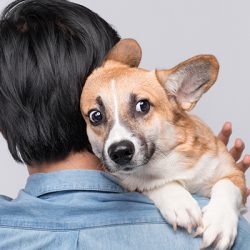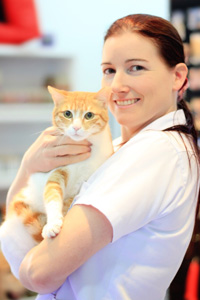September 13, 2020 by Dr. Sigrun Hackl
Do animals talk to us?
Of course they do, and nobody who has ever spent more than a few hours in the company of a pet, will usually disagree. Yet, not all of us can speak their language. Or understand.
So how do they communicate, and how much do they understand from our spoken language?
A lot more than we think, it seems.
Let’s take the dog, for example.
Some dogs have shown that they can understand the actual meaning of a large number of spoken words by correctly identifying and retrieving the requested object, and even identifying objects by elimination, when asked for a new item out of a range of known toys.
But far more striking than this is the deep felt understanding that every dog shows towards their owners. This is usually less based on verbal understanding, but more likely a deep sense for our body language and emotions, that our four-legged friends appear to respond to. Our pets will show us their connection and concerns in whatever way they have found to communicate with us.
And us? Do we understand them in return?
Sadly, not half as well as they understand us, and not nearly as well as we should.
Just take a look at the thousands of ‘cute’ dog pictures on the internet, all with a child hugging, jumping, riding or otherwise intruding into a dog’s personal space, and the outcry of despair in the dog’s faces and body language, begging for help. Do you see it?






If so, well done, for most people just see the ‘cute’. They do not understand the meaning of the ‘whale eye’, a turned eyeball that is showing the whites and is a clear sign of distress, a dog’s visual attempt to ‘escape’. They do not understand the meaning of repeated tongue flicks and lip licking, that is a dog’s desperate attempt to beg for a peaceful and less stressful situation, a quiet resolution to a problem they have and want our help with. People ignore the drawn back ears and turned heads that all say ‘Please, I am not comfortable, give me more space!’
When the dog finally resorts to a growl to make himself understood, he will frequently be told off for ‘bad’ behaviour. Yet, he is only trying to communicate with an apparently blind or insensitive family member!


Think about it. If we ignore the visual signs, and punish the vocal signs of warning, distress and begging for a resolution, what options do we leave our canine friends with?
All too often, this leads to a seemingly ‘unprovoked’ and totally ‘unexpected’ attack and bite, a desperate dog not knowing how else to make their needs understood after repeated attempts were ignored, or worse, punished. A sad outcome.
So open your eyes to hear the cries for help, as they are visual signs and not ‘spoken.’ Understand the growl as a form of communication and attempt to adjust the situation, rather than punish the dog for trying to find a resolution to a problem. Understand personal space and closely monitor especially small children around your pets, as they also need to understand the animal’s personal space and what is ‘allowed’ in terms of interaction. Most dogs will tolerate a tight hug, understanding that WE, the humans, need the hug. Most dogs hate the hug, it is far too close and intimidating for them. Yet, to please us, they endure it. That is their nature.


Think about it. If we ignore the visual signs, and punish the vocal signs of warning, distress and begging for a resolution, what options do we leave our canine friends with?
All too often, this leads to a seemingly ‘unprovoked’ and totally ‘unexpected’ attack and bite, a desperate dog not knowing how else to make their needs understood after repeated attempts were ignored, or worse, punished. A sad outcome.
So open your eyes to hear the cries for help, as they are visual signs and not ‘spoken.’ Understand the growl as a form of communication and attempt to adjust the situation, rather than punish the dog for trying to find a resolution to a problem. Understand personal space and closely monitor especially small children around your pets, as they also need to understand the animal’s personal space and what is ‘allowed’ in terms of interaction. Most dogs will tolerate a tight hug, understanding that WE, the humans, need the hug. Most dogs hate the hug, it is far too close and intimidating for them. Yet, to please us, they endure it. That is their nature.
No dog likes to have their ears and tail pulled or being jumped on, no matter how small the child. Again, many will agree to endure it, simply out of love for their human.
But is that an excuse to make them endure it? Should we not educate even a small child that Rex or Rosie can feel pain when treated that way and will not enjoy it?
Pay attention to the little details of body language and communication and make your dog’s life fulfilled and full of true love that will certainly go both ways. Avoid misunderstandings out of ignorance. Many accidents and bites can be avoided as well.
Read more about pets communication in our next blog, “Pillow Talk – Part II”.

Veterinary Surgeon
Street 70, Next to Premier Inn Hotel, Dubai Investments Park,
Green Community – Dubai, UAE
Our Opening Hours:
Monday to Friday : 9:00 am to 9:00 pm
Saturday and Sunday : 10:00 am to 8:00 pm
Damac Hills 2 Community Mall, Dubai, UAE
Our Opening Hours:
Everyday : 9:00 am to 8:00 pm
Blue Oasis Veterinary Clinic
Copyright© 2008 All rights reserved